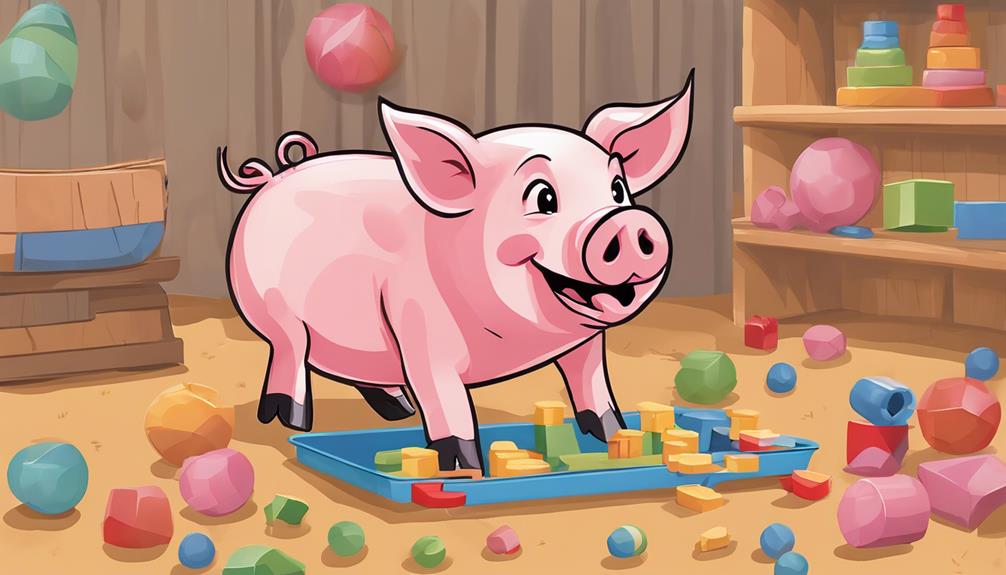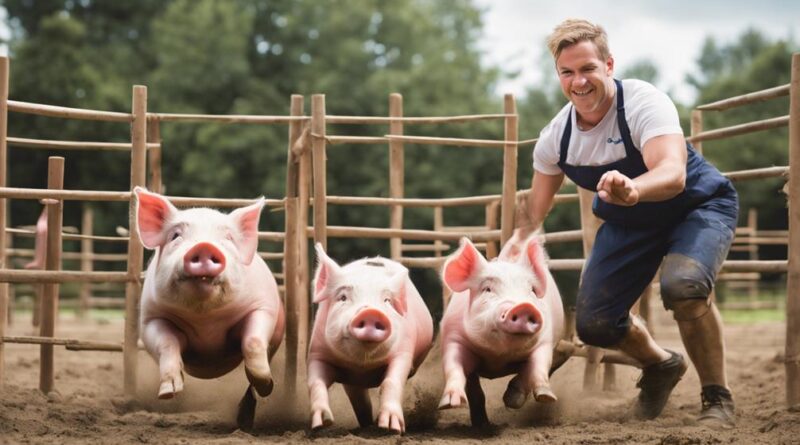Top-notch Tips for Professional Pig Training Services
When it comes to professional pig training services, pigs are incredibly intelligent animals, ranking fourth in animal intelligence behind chimpanzees, dolphins, and elephants. Understanding their behavior is key to successful training.
But, what really sets apart top-notch pig trainers from the rest? Let's explore the essential tips that can elevate your pig training services to the next level.
Understanding Pig Behavior
To effectively train pigs, it's crucial to understand their behavior patterns and instincts. Pigs are social animals that rely heavily on behavioral cues and communication signals within their herd dynamics. Understanding these elements is key to successful pig training.
Behavioral cues play a significant role in how pigs interact with each other and their environment. By observing your pigs closely, you can pick up on cues such as ear movements, body posture, and vocalizations that indicate their current emotional state. For instance, a pig with its ears flattened and body tense may be showing signs of aggression or fear, while a relaxed pig with wagging tail is likely content.
Communication signals also play a vital role in pig behavior. Pigs use various vocalizations, such as grunts, squeals, and oinks, to convey different messages to one another. Learning to interpret these sounds can help you understand your pigs' needs and emotions better.
Moreover, pigs have a well-defined social hierarchy within their herd dynamics. They establish dominance through behaviors like nudging, mounting, or vocalizations. As a trainer, recognizing and respecting this hierarchy is crucial when working with multiple pigs to avoid conflicts and promote harmonious interactions.
Establishing Trust and Bonding
Building trust and fostering a strong bond with your pigs is essential for successful pig training. To establish trust and bonding with your pigs, consider the following tips:
- Spend Quality Time Together: Building relationships with your pigs requires spending quality time with them. Interact with them daily, talk to them in a soothing voice, and engage in gentle petting sessions to help them feel comfortable around you.
- Use Positive Body Language: Pigs are highly perceptive animals, and they can pick up on your body language. Use open and non-threatening body gestures to communicate your intentions clearly. This helps in gaining confidence and trust from your pigs.
- Offer Treats and Rewards: One effective way of gaining confidence from pigs is by offering them treats and rewards when they exhibit positive behavior. This positive reinforcement technique helps in strengthening the bond between you and your pigs.
- Be Patient and Consistent: Building trust takes time, so be patient with your pigs. Consistency in your training methods and interactions is key to gaining their confidence. Avoid sudden changes in routine, as this can disrupt the trust-building process.
Implementing Positive Reinforcement Techniques
To effectively implement positive reinforcement techniques in pig training, focus on rewarding desired behaviors consistently. Building rapport with your pig is essential for successful training. Pigs, like many animals, respond well to positive reinforcement. By reinforcing behaviors you want to see more of, you can effectively train your pig and strengthen your bond.
When training your pig, make sure to use rewards that are highly motivating for them. This could be tasty treats, verbal praise, or a good scratch behind the ears. The key is to find what works best for your pig and use it consistently to reinforce positive behaviors. For example, if you're teaching your pig to sit on command, reward them with a treat every time they successfully sit. This will help them associate sitting with a positive outcome.
Consistency is key when implementing positive reinforcement techniques. Make sure to reward your pig every time they exhibit the desired behavior. This will help them understand what's expected of them and encourage them to repeat the behavior in the future. Remember, building a strong foundation of positive reinforcement will set you and your pig up for success in training.
Setting Clear Training Goals
When setting clear training goals for your pig, prioritize specificity to enhance training effectiveness. Setting vague objectives can lead to confusion and slow progress. To ensure successful pig training, consider the following strategies:
- Define Specific Goals: Clearly outline the behaviors or tricks you want your pig to learn. For example, instead of a broad goal like 'improve obedience,' specify 'mastering sit and stay commands.'
- Break Down Goals into Achievable Steps: Divide complex tasks into smaller, manageable parts. This approach helps prevent overwhelm and allows for steady progress tracking.
- Use Positive Reinforcement: Reward desired behaviors promptly to encourage repetition. Positive reinforcement is a powerful tool for behavior modification and enhances training effectiveness.
- Track Training Progress: Keep a training journal to monitor your pig's advancements and identify areas that may need more focus. Tracking progress allows you to adjust strategies as needed for optimal results.
Consistency in Training Sessions
For effective pig training, maintaining consistency in your training sessions is key to reinforcing desired behaviors and promoting learning retention. Establish a regular training schedule to provide structure and predictability for your pigs. Consistency in timing and duration of sessions helps pigs understand what's expected of them, leading to better results. Additionally, consistency in the use of rewards is crucial. Rewarding desired behaviors promptly and consistently reinforces the positive actions, making it more likely for the pigs to repeat them in the future.
Patience is essential when striving for consistency in training sessions. Pigs, like any other animals, require time to understand and respond to your commands. Be patient and give them the opportunity to learn at their own pace. Remember that consistency in your interactions with the pigs helps build trust and confidence, leading to a stronger bond between you and the animals.
Repetition is another key aspect of maintaining consistency in training. Repeating commands and exercises helps reinforce learning and ensures that the pigs retain the information. Consistent repetition of training routines also helps establish clear expectations for the pigs, making it easier for them to understand what's required of them.
Handling Behavioral Challenges
How can you effectively address behavioral challenges when training pigs?
When it comes to handling behavioral challenges in pig training, it's essential to employ specific strategies and techniques to ensure successful outcomes. Here are some key points to keep in mind:
- Behavioral Modification Strategies: Implementing effective behavioral modification techniques can help address issues such as fearfulness, aggression, or stubbornness in pigs. Consistency and positive reinforcement are crucial elements in modifying unwanted behaviors.
- Aggression Management: Dealing with aggression in pigs requires a careful approach. Understanding the root cause of the aggression and using techniques like desensitization and counterconditioning can help manage and reduce aggressive behaviors.
- Communication Techniques: Clear communication is vital when training pigs. Using consistent cues, body language, and vocal commands can help convey your expectations to the pigs effectively.
- Problem-Solving Approaches: When faced with behavioral challenges, it's important to approach them as a puzzle to solve. Analyzing the behavior, identifying triggers, and devising a structured plan can aid in addressing and overcoming the issues at hand.
Utilizing Enrichment Activities

To further enhance the training experience and well-being of your pigs, incorporating enriching activities into their routine can be highly beneficial. Engagement strategies play a crucial role in keeping your pigs mentally stimulated, leading to a more fulfilling training process.
One effective way to provide mental stimulation is through puzzle feeders. These feeders require pigs to work for their food, encouraging problem-solving skills and keeping them engaged. Additionally, you can introduce novel objects into their environment regularly. Pigs are naturally curious animals, and new items spark their interest, preventing boredom and promoting mental agility.
Interactive toys are another fantastic way to engage your pigs. Balls that dispense treats when rolled or toys that require pushing and rooting can keep your pigs entertained while offering mental enrichment. Rotating these toys periodically will maintain their novelty factor and prevent them from losing interest.
Creating obstacle courses or setting up scavenger hunts can also be engaging activities for your pigs. These activities not only provide physical exercise but also challenge their cognitive abilities. By varying the layout and difficulty level of these courses, you can continuously challenge your pigs and promote their problem-solving skills.
Monitoring and Evaluating Progress
As you embark on the journey of training your pigs, it's essential to establish a system for monitoring and evaluating their progress regularly. Tracking progress and performance metrics is crucial to ensure that your pigs are advancing in their training effectively. Here are some top-notch tips to help you monitor and evaluate the progress of your pig training:
- Set Clear Goals: Define specific and achievable training goals for your pigs. Having clear objectives will make it easier to track their progress accurately.
- Use Performance Metrics: Implement performance metrics such as behavior assessments, task completion rates, and learning speed to quantitatively measure your pigs' progress.
- Regular Check-ins: Schedule regular check-ins to assess how well your pigs are responding to training and whether any adjustments are needed to enhance their learning experience.
- Reward System: Establish a reward system tied to the achievement of training milestones. Positive reinforcement can motivate your pigs and indicate their progress effectively.
Frequently Asked Questions
Are There Any Specific Breeds of Pigs That Are Easier to Train Than Others?
When choosing a pig breed for training, some may find certain breeds easier to work with than others. Techniques like clicker training and positive reinforcement can be effective across breeds, but some pigs, like the Miniature Potbelly or the Hampshire, might be more receptive to training due to their intelligence and temperament.
Can Pigs Be Trained to Perform Specific Tasks or Tricks?
Yes, pigs can be trained to perform specific tasks or tricks. Their intelligence and problem-solving abilities make them great candidates for training.
Using positive reinforcement techniques like clicker training can help you effectively teach pigs new behaviors. By rewarding desired actions, you can encourage them to learn and perform various tasks.
With patience and consistency, you can train pigs to do impressive tricks and tasks.
How Long Does It Typically Take to See Progress in a Pig's Training?
When training pigs, progress can vary based on the task complexity and the individual animal. Typically, you'll start seeing some progress within the first few training sessions.
By using consistent reward systems and reinforcement techniques, you can track progress effectively. Keep an eye on small improvements as they indicate your pig is learning.
What Are Some Common Mistakes That Pig Owners Make When Trying to Train Their Pigs?
When training your pig, common mistakes include inconsistency, using punishment instead of positive reinforcement, and not being patient.
To avoid these errors, stick to a consistent training schedule, reward good behavior with treats or praise, and stay calm even when progress is slow.
Effective techniques involve using clicker training, breaking tasks into smaller steps, and creating a positive training environment.
Is There a Limit to What Behaviors Can Be Trained in Pigs, or Are There Certain Behaviors That Are More Difficult to Train Than Others?
When training pigs, there are limitations to what behaviors can be taught, but with patience and dedication, you can achieve advanced training goals. Some behaviors may pose challenges and be more difficult to train than others, such as complex tricks or behaviors that go against natural instincts.
However, with the right approach and consistent training methods, even these challenging behaviors can be successfully taught over time.
Conclusion
In conclusion, mastering the art of professional pig training services requires a deep understanding of pig behavior. Building trust and bonding, using positive reinforcement techniques, and setting clear goals are essential. Consistency in training, handling challenges, incorporating enrichment activities, and monitoring progress are also key aspects.
By following these top-notch tips, you can become a skilled pig trainer and provide exceptional care for these intelligent and lovable animals. Keep up the hard work and dedication to achieve success in your pig training endeavors!
